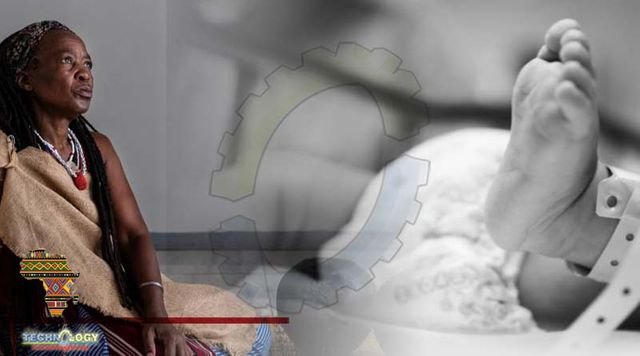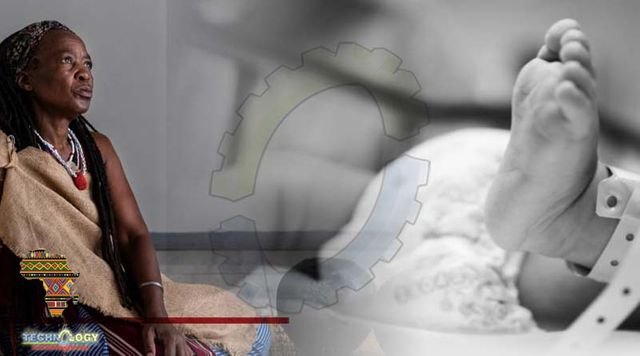A Sangoma Campaigns to Protect Intersex Newborns A Johannesburg healer and birth attendant fights tirelessly to change the way communities perceive intersex babies, who are sometimes strangled after they are born.

“Look at all this rain! It’s a good sign,” Poppy Ngubeni, 60, says as she opens the gate to her Johannesburg south home. Taking dainty steps in a futile attempt to dodge the puddles leading up to her front door, Ngubeni adds: “In our culture, the rain is a blessing when we do something like this.”
Ngubeni is a sangoma and independent researcher who, whenever an opportunity presents itself, travels to various parts of the country to speak with abelaphi (diviners, healers and initiates) in an attempt to change their perceptions of intersex people, and intersex newborns, in particular. Today Ngubeni is, for the first time, conducting such an engagement in her own home.
It was in 2015, after a visit to KwaZulu-Natal, that Ngubeni, a former nurse, started these engagements. “I was doing that research in KwaZulu-Natal … It was there that I picked up the issue of intersex born babies. There was an old man who told me that [abelaphi birth attendants or midwives] know that there are some children who are born with two sex organs. I asked, ‘And then, what do they do?’ He didn’t just jump into it and say, ‘They strangle them.’ No. He prepared me beforehand. He said, ‘You know what, they just make sure that this child doesn’t go through any pain, that mummy doesn’t go through any pain, and that the family doesn’t go through any pain. So they strangle that baby and that baby is buried … They just twist the child’s neck and they go to the makoti and say, ‘Makoti, the child passed on. He was tired.’ … He could see I was not happy but … he said it was an act of love – for the baby and for the family. That they were saving that woman from pain and embarrassment and protecting the child, saving it from being a mockery.”
The Intersex Society of North America defines intersex as a “general term used for a variety of conditions in which a person is born with a reproductive or sexual anatomy that doesn’t seem to fit the typical definitions of female or male”.
“A person might be born appearing to be female on the outside, but having mostly male-typical anatomy on the inside. Or a person may be born with genitals that seem to be in-between the usual male and female types. For example, a girl may be born with a noticeably large clitoris or lacking a vaginal opening, or a boy may be born with a notably small penis or with a scrotum that is divided so that it has formed more like a labia. Or a person born with mosaic genetics, so that some of her cells have XX chromosomes and some of them have XY.”
David Segal, a Johannesburg-based paediatric endocrinologist, says it is estimated that one in 1 000 people in South Africa are born intersex – one of the highest prevalence rates in the world.
From 2008 to 2010, the now-defunct queer rights organisation Legbo Northern Cape conducted interviews with midwives and abelaphi birth attendants across the province. The organisation’s former director, Shaine Griqua, said the research was undertaken after a midwife in one of the villages said that “when she ‘sees funny things’ on a child, she would … ‘get rid of the child’. She felt it was her responsibility to do this because [these children] were a punishment from God.”
Her mission comes with its own set of challenges. “With certain people, as soon as you come there and they see you are a sangoma, they don’t want to talk to you. But fortunately, when I’m in rural areas, they respect traditional medicine. But, sometimes I have to come up with a plan … [One time] I had to take off [all traditional wear] and dress in my [regular clothes] like I was a private detective and went to a prayer meeting. I was given a chance to participate in preaching and then after, when we were having tea, I said, ‘Guys, I forgot to tell you I’m a traditional healer.’ So I had to trick them into listening to me. But they said to me, ‘We never thought a traditional healer could know God’,” she says, letting out a loud, raspy laugh.
Bishop Bongani Nkosi, one of the attendees, concedes that even discussing this in a church setting would be difficult. “[By raising this topic in church] people will not want to associate with you as a pastor because you allowed it [to be discussed]. They will not want to associate with the church. They will not want to associate with you as a mother and your child. They will say it is demonic, satanic, devilish.”
Crystal Hendricks, Iranti’s intersex rights programmes officer, agrees. “When we got to that meeting, [the izamgoma and leaders] didn’t understand anything about what intersex is. They saw it as a sexuality. So I think it’s really important that you have someone that understands traditional healing speak to them. Because I felt that, even though we had an engagement with traditional healers, I still felt like we needed multiple sessions and not just that one day. Because somehow they still left there not having all the knowledge of what intersex, you know, really is.”
Ngubeni is elated. “But I am not the only person who is happy. We are all happy. You know why? People will ask me, ‘Why do you feel this strong about this? Why?’ And I say, ‘Guys, these are souls in our communities and our nation that we are turning our backs on, shunning them.’ So I feel like I’ve achieved something I’ve been looking for for three or four years. And everybody was happy. That is why I am happy. Everybody said, ‘You know what, it was worth it, coming out in that rain to come to that meeting.”
Source: This news is originally published by allafrica
